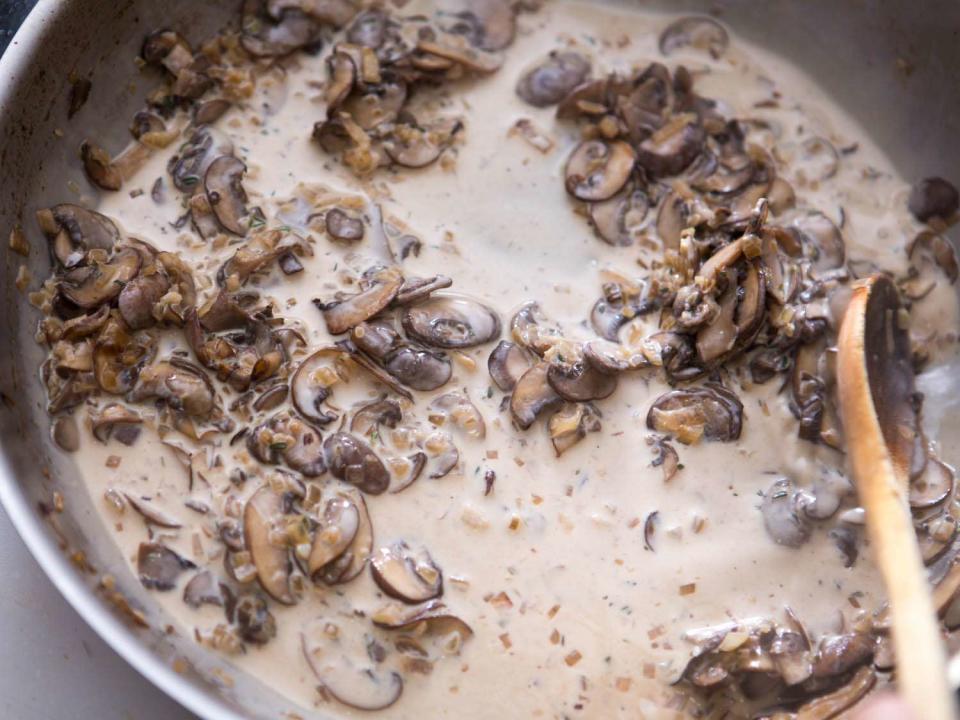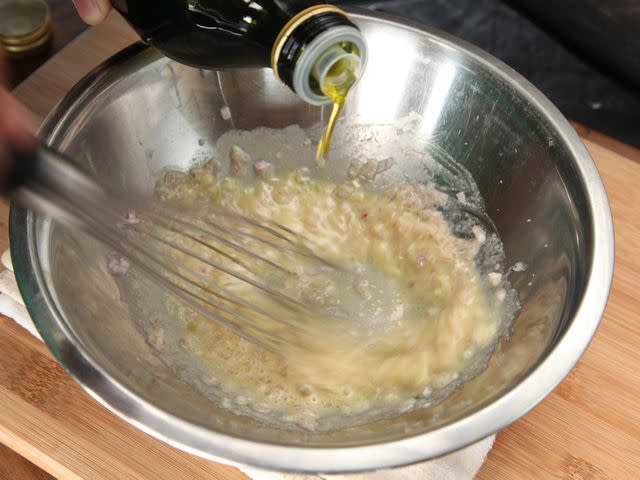How to Fix a Broken Sauce or Vinaigrette
Pan sauces, egg sauces, and vinaigrettes can separate or fail to come together into a cohesive sauce, but don't worry: saving them is a snap.

Serious Eats / Vicky Wasik
I make a vinaigrette almost every single day. Most of the time, I make the one my parents used to make: I combine lemon juice, Dijon mustard, minced garlic, a splash of Worcestershire, and a couple hits of Tabasco in a mixing bowl, then drizzle in olive oil in a steady stream, whisking the mixture up with the tines of a small fork until it forms a loose emulsion. It's not anywhere close to restaurant-quality. If I'm being honest, it's always a little heavy on the acid. But even though I can be slightly cavalier about proper ratios, it usually comes together without a hitch.
Sometimes, though, the oil won't stick. By which I mean, I'll add too much oil too quickly, and instead of seamlessly and fully incorporating into the mustard-and-lemon slurry, it'll start pooling on top. No matter how quickly I stir, the oil will refuse to mix with the other liquid. Voilà: a broken vinaigrette.
Few culinary failures enrage me so much. In the moment when it becomes clear that the emulsion has broken, the main source of my frustration is the fact that I should have known better. We've published very clear instructions for making a vinaigrette: Use a large mixing bowl and a whisk, and pay attention to the proportions. If I followed those directions precisely, I'd never have this problem. But after my most recent slip-up, it dawned on me that, while we have plenty of instruction in how to make a proper emulsion—from Kenji's foolproof hollandaise and béarnaise recipes to Daniel's and Kenji's extensive explainers on pan sauces—we don't have a whole lot of guidance on what to do when an emulsion breaks. To rectify that, we've assembled some easy steps you can take to salvage emulsified sauces of any kind.
Egg-Based Sauces

Egg-based sauces include classics like mayonnaise and the aforementioned hollandaise and béarnaise. We call our recipes for these sauces "foolproof" with good reason: They guarantee stable, emulsified sauces if the instructions are followed to the letter. But if you're following a different recipe, or if you like the challenge of employing a more classical technique, or if your sauce breaks because your equipment isn't quite what we call for in our recipes, don't worry—you don't have to throw all those egg yolks out.
Fixing any broken egg-based emulsion requires the same method: Create a new emulsion, then whisk the broken one into it. You can do this by placing a teaspoon of lemon juice (or water) in a clean bowl and adding a small amount of the broken emulsion, whisking to form another, stable emulsion. Once that emulsion forms, drizzle in the rest of the broken sauce, whisking constantly.
Alternatively, you can create an emulsion with an egg yolk and an acid, like lemon juice, to which you'll then add the broken sauce, a little at a time, whisking constantly. If you choose the egg yolk route, you may need to thin out the resulting sauce a bit with water.
Pan Sauces

Serious Eats / Vicky Wasik
Pan sauces are butterfat-in-water emulsions that essentially serve as a vehicle for all the tasty stuff left in the bottom of a sauté pan or roasting pan, rescuing it from the pot and getting it onto your plate. These sauces rely on stock with a high gelatin content to help the liquid in the pan hold on to fat molecules and prevent them from coalescing, which would result in a slick of oil on top of a thin, very highly seasoned layer of liquid. Here, emulsification is accomplished through rapid agitation of the mixture of fat and liquid, which comes from whisking and boiling.
Read More: How to Make a Pan Sauce, and How to Fix a Broken One
In contrast with egg-based emulsions, which cannot be rapidly boiled (because the high heat would curdle the eggs), pan sauces will usually break only when there isn't enough liquid to hold the fat in suspension. If your pan sauce is broken, all you need to do is add a splash of water and swirl to bring it back together.
Vinaigrettes

Serious Eats / J. Kenji López-Alt
Back to my unlovely broken vinaigrette. As with egg-based sauces, you don't have the option of boiling to agitate your vinaigrette; instead, you're left with mechanical means that don't heat up the mixture.
The easiest way to achieve a stable emulsion is to use a blender, but we don't recommend this if you've used olive oil in your dressing: The rapid beating of olive oil will cause it to oxidize and turn bitter. Better to just dump the mixture in a container—a squeeze bottle, say—and give it a good, thorough shake. Or, you could do what I've resolved to do from now on: focus on getting it right the first time.
September 2017
Read the original article on Serious Eats.

